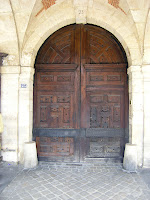The crest of SCHAAFHEIM on the wall of the Town Hall.

The topics of this blog are Armand-Jean du Plessis, Cardinal Duke of Richelieu, and the IDEAL CITY built on his command next to his magnificent CHÂTEAU on the borders of Touraine, Anjou and Poitou, in France.








 These three views show the garden side of this hôtel particulier - or private mansion - that has been adapted as a set of small apartments for seniors. One can see the body of the original main house and then the dependances - extensions - that were added to it over the years. Many of these buildings were until recently in a terrible state and really needed major restoration, such as has happened in this particular case. It is of course sad that such grand houses cannot stay in individual ownership, but sub-division often occurred in the 17th century shortly after the death of the cardinal in 1642 as his court dissolved to reorganise themselves around the new regime of the young future Roi Soleil, King Louis XIV and his new first minister the cardinal Mazarin; Richelieu's recommendation to the regent dowager Queen Anne of Austria.
These three views show the garden side of this hôtel particulier - or private mansion - that has been adapted as a set of small apartments for seniors. One can see the body of the original main house and then the dependances - extensions - that were added to it over the years. Many of these buildings were until recently in a terrible state and really needed major restoration, such as has happened in this particular case. It is of course sad that such grand houses cannot stay in individual ownership, but sub-division often occurred in the 17th century shortly after the death of the cardinal in 1642 as his court dissolved to reorganise themselves around the new regime of the young future Roi Soleil, King Louis XIV and his new first minister the cardinal Mazarin; Richelieu's recommendation to the regent dowager Queen Anne of Austria.


















 The GREAT MAN's old bed is located in the William Randolph Hearst mansion in California. This is the house satirised in the film 'Citizen Cane' directed by Orson Welles. The old bed graced the voluptuous guest suite and can be seen there to this day. The best view we have found of the bed itself is from an old postcard of the '50s.
The GREAT MAN's old bed is located in the William Randolph Hearst mansion in California. This is the house satirised in the film 'Citizen Cane' directed by Orson Welles. The old bed graced the voluptuous guest suite and can be seen there to this day. The best view we have found of the bed itself is from an old postcard of the '50s.















